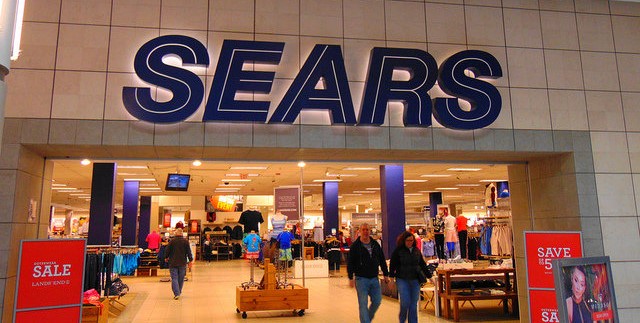
Image source: JJBers via Flickr
Nostalgia could not save legacy brands like Sears, Payless ShoeSource or Toys R Us. Those brands filed for bankruptcy and closed hundreds of stores across the county.
Many people feel deeply connected to legacy brands and grieved over their demise. After reporting on the downfall Sears, The Wall Street Journal received hundreds of emails and messages from readers who shared their personal stories of shopping at the stores as children with their parent and of their pride of working at Sears.
Stephanie Earls, a columnist for The Gazette in Colorado Springs, CO., lamented the closing of two local Sears stores. But she also admitted that her visit to the store to report on the closing was the first time she had been to Sears in a decade. “I left empty-handed, and a little heavier-hearted,” she wrote.
Why Legacy Brands Lost Customers
How did long-established, well-known retailers that once enjoyed robust sales end up in bankruptcy? They thought customers would keep returning. They didn’t understand why they lost customers to competitors and how customer relationships can crumble over time. They generally failed to keep pace with competitors, changing consumer tastes, and the growth of online sales.
While legacy brands fell into bankruptcy, others such as Gillette and Johnson & Johnson remain but are struggling.
Some say customers did not leave the legacy brands. The brands abandoned customers. “To me, it looks like the brands are consistently giving the customer the signal that they are done with them, that they are not going … to give them what they expect from the brand and what they used to offer,” Santiago Gallino, a Wharton professor of operations, information and decisions, told Knowledge@Wharton.
How Established Brands Can Survive and Thrive
Become a trusted curator. Customers want retailers that vet products — retailers that place only quality products on their shelves and stand behind those products. Costco is a prime example of such a trusted curator. “If you go to Costco and talk about Costco with other customers, it’s clear that the role of the retailer as curator is very prominent,” Gallino says. “They will trust something Costco sells just because it’s there.”
Access influencers. Marketers at older brands can reach customers through social media and influencer marketing, writes Holly Pavlika, head of marketing and PR for Inmar, in Forbes. Many consumers now use social media to make purchase decisions, Pavlika notes. Delivering honest, informative and enjoyable content through influencers can establish relationships, change perceptions and drive sales.
The strategy requires removing the “creative handcuffs” from your influencers. Trust your influencers to know their audience, and let them tell the tale their way. Heavy-handed control risks losing the authenticity that’s the basis of effective influencer marketing.
Evolve the brand’s image. Some brands fear losing their original, distinct image as they evolve. If a brand veers from its brand voice and message, consumers may doubt its authenticity. However, brands need to take risks to adapt, states Agency Sparks. Being content with their historical appeal will not attract new customers. As brands age, so does their initial consumer base. Brands must walk the line between maintaining a solid connection and relationship with loyal followers while appealing to new consumer tastes.
Watch changing tastes. Brands that pay attention to changing tastes and habits can deliver products consumers want. Baby food company Beech-Nut Nutrition, founded in 1891, discovered that mothers made homemade food for their babies because they wanted to know the exact ingredients. The company simplified its ingredients and marketed how the product saves mothers time and effort while delivering quality food for babies.
“For legacy brands, managers continually face the binary choice between ignominious decline and miraculous rebirth. The trick to making miracles is to stop looking in the mirror and look, instead, to customers and prospects for solutions,” says Kirk Cheyfitz, co-founder of Story Worldwide, which helped Beech-Nut market its story.
Many brands find that social media analytics provides a powerful marketing research tool. While it may not completely supplant traditional marketing research techniques, social media analytics provides data faster and more affordably than other methods.
Embrace storytelling. LEGO avoided bankruptcy and began rebuilding its brand through the power of stories. It reached licensing deals with Star Wars and Harry Potter to release products based on those stories. LEGO also uncovered the storytelling power in its mini-figures of everyday people: police stations, firehouses and ordinary homes, villages and cities;
“From the point of view of the kids, I think what LEGO learned from Star Wars is the power of the story. If you have this rich world with a story that plays out in that world, kids love to build that world and then play the story out in that world with their little mini-figures and then rebuild it and try things in different ways,” states Wharton Professor David Robertson, co-author of LEGO history Brick by Brick.
Return to nostalgia. Research shows that rousing feelings of nostalgia can encourage purchases, says Barbara E. Kahn, a Wharton marketing professor. A research paper published in the Journal of Consumer Research determined that nostalgia “weakens the desire for money.” Some brands, such as Nike, Apple and Patagonia, excel at combining nostalgia and innovation, Kahn says. Others struggle to marry their brand’s history with evolving customer tastes and simultaneously keep current customers happy and attract new ones.
Bottom Line: Many legacy brands have disappeared or continue to struggle. Organizations that don’t monitor changing consumer preferences and adapt to those changes risk extinction. The challenge is to update the brand’s image to meet changing times while keeping elements that caused its initial success.
William J. Comcowich founded and served as CEO of CyberAlert LLC, the predecessor of Glean.info. He is currently serving as Interim CEO and member of the Board of Directors. Glean.info provides customized media monitoring, media measurement and analytics solutions across all types of traditional and social media.




